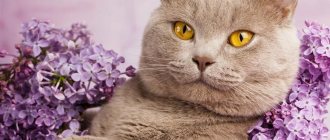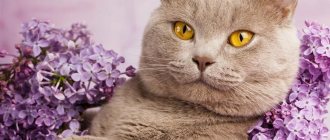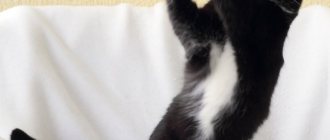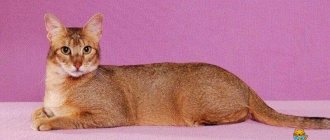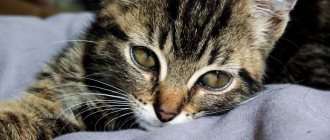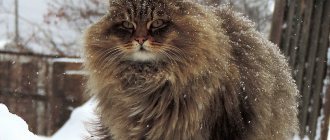Description of the Burmese cat breed
Popularity 57th place among 86 cat breeds
Lifespan:
14-16 years old
Height:
from 28 to 32 cm
Country of origin:
Myanmar
Average price:
30-40 thousand rubles
Weight:
from 4.5 to 8 kg
Latest articles Cat care
How to trim a cat's claws correctly and easily 01/28/2022 137 0 0
Dog health
How to do an ultrasound for dogs: preparation and procedure 01/28/2022 62 0 0
Key facts
The official name of the breed is the Burmese cat, or sacred Burma. The name is based on the country of origin - a state in Southeast Asia called Myanmar. Burma is its former name, popular among foreigners and lasting until 1989. In English pronunciation this word sounds like “Burma”, which often misleads people. The Burmese and Burmese cat breeds do share a common country of origin, but have completely different appearances. The description of the Burmese cat includes having long hair and a color-point coat, while the Burmese's coat is short and darker.
The average lifespan of a Burmese cat is 15 years. She has good health and a balanced character. The greatest friendliness is characteristic of males. They quickly find a common language with other animals, enjoy playing with children and are not afraid of strangers.
Among the key characteristics of the Burmese cat breed, it is important to note extreme curiosity and perseverance. These animals know how to achieve their desires, so sometimes they are too annoying.
One of the most famous Burmas is the Choupette cat, which belonged to the German fashion designer Karl Lagerfeld. After the owner's death, she inherited $200 million.
Description of the Burmese breed and standards
The Burmese breed has distinctive features - white paws, pink pads, and wide-set blue eyes.
Head and muzzle
Burmese cats have a triangular head shape, the contour of which gradually becomes rounded. The zygomatic bone is located high, the frontal part protrudes forward. Cats have a fairly large nose. The ears are small in size with rounded tips. The Burmese's eyes are wide-set and almond-shaped.
Frame
This breed is characterized by medium body size and well-developed muscles. The limbs are low, ending in wide paws. The tail is usually short.
Coat
Burmese cats have a medium-length coat with short undercoat. On the head it lengthens towards the cheeks, after which it turns into a fairly thick fur collar. The tail is distinguished by thick, long hair. The longest hair is on the side of the body and back.
Colors
Burmese cats have a characteristic color - the body has a smooth white color, turning into a dark color closer to the forelimbs, and white “gloves” and “socks” are required. The fur on the face is dark in color and extends to the ears. The tail part is painted dark. The pads most often have a pink tint and may have spots.
The color of Burmese cats is very diverse, a combination is possible:
- brown markings on a background of beige fur;
- chocolate color with ivory;
- blue shadows against a background of light blue wool.
History of the origin of the Burmese cat
The exact country of origin of the breed is unknown, since the Burmese received its first official recognition in France in 1925. Felinologists suggest that the animals were brought from Myanmar by an American billionaire who took a cruise to eastern countries in 1919.
The man gave a considerable part of his fortune for two kittens, but only the girl survived the journey. It was she who became the founder of the European line. In the second half of the 20th century, furry animals were recognized by all felinological organizations.
It is believed that the appearance of the cats was achieved through matings of Siamese and Persians. Residents of Myanmar claim that mentions of these cats date back to ancient times and contain many interesting facts. One of them explains why animals are called sacred.
At the temples of the goddess Tsun Huan Ce, the guide of souls in the afterlife, with the death of some monks, black and white cats with golden eyes appeared. Buddhists believed that these were messengers of the goddess who had arrived to protect the temple, and treated them with special respect. One day, during an attack by robbers, one of the cats named Singh came to the defense of the monks. His fur glowed with a golden glow and his eyes changed color to bright blue. This scared off the bandits and helped defend the temple.
What does a Burmese cat look like?
A photo of a Burmese cat shows an amazing resemblance to Siamese and Himalayans. This breed is suitable for those who are delighted with the Siamese color and Himalayan coat, but consider a thin body or flattened muzzle not beautiful enough. Along with its attractive appearance, a bonus to the Burmese is its docile and friendly character. The weight of these animals is 4-6 kg, and their height at the withers is about 30 cm. Boys are always larger than girls, so they usually weigh at least 5 kg.
Muzzle
The breed is characterized by a rounded head. Its width is slightly shorter than its length. The animal has a slightly convex forehead, rounded cheeks and a strong chin. According to the standards, 2 varieties of Burmese cats are allowed: with a pronounced stop for TICA and the absence of a transition from the muzzle to the “Roman” nose for FIFe. The calling card of the breed is its round, expressive sapphire-colored eyes. Their color varies from light blue to deep blue. Unlike other cats, blue eyes do not have a negative effect on hearing. The small ears are slightly tilted forward, rounded at the tips and pubescent on the inside.
Possible defects include squint, a different eye color, or the presence of a silvery sheen in them. An animal with such an appearance will be classified as a pet class and will not be allowed for breeding.
Body type
The head is located on a slightly muscular and wide neck. The body of the Burmese is squat and elongated, with powerful bones. The hind and forelimbs are thick and muscular. They end in round and strong paws with tufts of hairs between the toes. The raised tail is pubescent. Its knobbiness or curvature is unacceptable.
Coat and color
The animal's fur has no undercoat and resembles silk. On the belly, the hairs curl into a light wave, and on the neck they grow into a luxurious mane. The main color of the Burmese cat is color point. Unlike Siamese, the standard of this breed allows for all possible markings: chocolate, lilac, gray, red. The color of most of the coat varies from white to cream.
The dark markings present on the tail, ears, limbs and muzzle match the appearance of the Siamese. A distinctive feature of Burmese is considered to be white “socks” on all four paws. Their absence will result in disqualification. Defects also include points on the light parts of the coat and light marks on the points.
Difference between Burma and Burmese
Despite the similar names, the Burmese cat differs in many ways from the Burmese. The most characteristic feature of the first breed is the silky coat, as well as the color - there are no white “gloves” and “socks”, dark markings on the face and limbs. The Burmese breed has brown, blue, sable and other types of colors.
Unlike Burmese, they have a different shape and set of eyes, the color of the iris is most often brown and its shades.
What does a Burmese cat look like?
Personality of the Burmese cat
If we talk about who is suitable for Burma, then it will be the elderly and owners with disabilities. These animals don't like noise. Loud screams of small children or frequent parties frighten them, negatively affecting their psyche. This breed also has an intolerant attitude towards loneliness. They quickly become attached to their owners and enjoy sitting in their arms.
The character of the Burmese cat is called balanced. She is characterized by playfulness and high intelligence. Despite the increased activity, the animal always keeps itself within certain limits. A furry pet will never offend a child, so it can suffer if handled incorrectly. She gets along well with other pets, but can become jealous if she notices that a person is paying more attention to them. Burmese owners claim that their pets can read their thoughts. Initially, this feature was noticed by Buddhist monks, who nicknamed the animals “the eye of heaven” for their piercing gaze.
One of the disadvantages of the breed is excessive obsession. It manifests itself when an animal wants something very badly. Excessive assertiveness can even make you angry, but you have to put up with this behavior. Your negative reaction or lack thereof will only offend Burma. In most cases, manipulation skills are used appropriately when the owner is in a good mood.
Character
Burmese cats have a friendly nature. They are not characterized by aggression and rancor. They get along well with children and become their true friends. Burmese love affection and require a lot of attention from their owners. In addition, animals are very hospitable, so when a new person appears in the house, the cat will not hide in a corner, but, on the contrary, will express a desire to get to know the guest.
By temperament, animals are prone to a low-active lifestyle: they love to lie on their owners’ laps, they easily get used to being handled, and at the same time they love active games.
Burmese have a high level of intelligence and respond to nicknames.
Raising a Burmese cat
Many owners do not understand how to stop their pets from scratching and chewing their hands. This problem often occurs due to improper training and games. The owner's hands are made for affection. They give food and should never hurt.
Also try not to use them for gaming. The exception is playing under a blanket. Most cats are convinced that they are hunting the “duvet monster” and not the owner.
When raising a Burmese cat, use punishment based on its character. The most effective method of punishment is ignoring. The main thing here is to make sure that the pet understands the reason for such treatment. If he went to the toilet past the tray while you were at work, then any punishment is already meaningless. In such a situation, the lack of affection will frighten the animal, which is detrimental to the psyche.
Another effective method of punishment is a stream of water. Use it when teaching prohibition commands. Burms are smart creatures. They will quickly realize the relationship and begin to stop their actions at the word “no”, without waiting for being sprayed with water.
Don't try to create a trained animal by doing the same thing as dogs. Your task is to correct behavior and get a well-mannered pet who is familiar with the basic prohibitions in your home.
Burmese cat health
Burms are long-lived cats. One of them, Lady Catalina from Australia, is immortalized on the pages of the Guinness Book of Records: her life expectancy was 35 years.
Thanks to careful selection, the health of the Burmese cat turned out to be quite strong. With regular visits to the veterinarian, timely treatment for parasites and the availability of all necessary vaccinations, Burmese live longer than other breeds.
Possible diseases
Hereditary diseases of Burmese include hypertrophic cardiomyopathy, corneal dermoids and vestibular disorders. If detected early, they are all treatable.
Heart problems are easily recognized by shortness of breath and coughing that appears immediately after active games. The presence of a dermoid (a sac-like tumor on the white of the eye) is visible to the naked eye. Coordination problems manifest themselves in unsteady gait and other balance problems.
Reproductive health
To obtain offspring, only purebred partners with pedigrees are used. Mating with other breeds, mestizos and representatives of the pet class is strictly prohibited. Due to the small number of representatives, felinological organizations strictly control all matings and can punish violators with a fine.
Pregnancy is a difficult test for the body. Frequent births, more than 3 times in 2 years, are prohibited. For Burmese cats, the conditions are less strict - they can mate twice a month.
Burmese are record holders not only in age, but also in the number of newborns. They usually give birth to up to 10 kittens, but one representative managed to give birth to as many as 19 babies. Coping with such a huge offspring is not so easy, so veterinarians recommend not torturing yourself or the animals. Immediately after the appearance of sexual activity, pets can be scheduled for sterilization or castration. For representatives of the pet class, this is the most reasonable solution, since they are not allowed for breeding.
Health
In terms of life expectancy, the Sacred Burmese surpasses many breeds, but is not a record long-liver. With proper care, your pet will live about 15 years without any health problems.
From the first months, a Burmese kitten needs vaccinations and protection against parasites. Universal drugs contain a combination of remedies against the most dangerous viruses and infections. Annual revaccination and deworming can significantly extend the life of the Burmese.
Despite high-quality feeding and care, the breed is prone to certain diseases:
- problems with the vestibular system;
- causeless body trembling in kittens;
- hypertrophic cardiomyopathy;
- corneal dermoids.
Features of feeding and diet
The cost of keeping a Burmese is quite high, since it does not favor dry food and canned food. Natural feeding is often more expensive, since in addition to food you have to buy vitamins. It is also worth considering the fastidiousness of the animal. Before you understand what to feed your pet, you will have to sweat in trying to recognize his favorite dish.
Of course, there are advantages to owning a Burma. She never suffers from obesity, because she knows her norm. Purebred pets will not eat everything that is poured into a bowl if the feeling of fullness has already set in. When preparing your diet, follow the general recommendations:
- Choose lean meats: chicken, rabbit, turkey. Pork and lamb are harmful to the kidneys and liver. Protein should form the basis of the diet.
- Use natural fermented milk products. Milk can only be given to kittens. After 1 year of age, all adult animals develop lactose intolerance.
- Supplement your main diet with a small amount of cereals and vegetables.
- Avoid any products that contain natural or artificial colors. They can change the color of the fur coat to a darker shade.
Feed adult pets twice a day, leaving no more than 250 g of food at one time, and even less dry food. It is enough for kittens to give 150 g of food 4-5 times a day. Calculating portions is necessary to ensure that the food does not spoil in the bowl. Remember that natural products are removed immediately after feeding.
Care and maintenance
The birthplace of Burma is one of the hottest countries. When purchasing a representative of this breed, please note that temperatures below 20°C are unacceptable for him. The fluffy pet easily catches colds in drafts and prefers to sleep under a blanket even in summer.
Caring for and maintaining a Burmese cat involves creating comfortable and safe conditions. The animal must not be taken outside, kept in a pen or small cage, or deprived of human contact.
The Burmese are afraid of precipitation, and winter is the most dangerous time of the year for them. Also, future owners should keep in mind the special property of the vestibular apparatus of these cats. Landing on four paws is impossible for them. If an animal falls out of a window from the second or even the first floor, it can be seriously injured, so installing an anti-cat device is a prerequisite.
If you are often away from home, then be sure to take care of interactive toys. Intellectual games are especially loved by this breed and help distract them in lonely hours. Although a more adequate option would be to buy another pet.
For the health and hygiene of your furry pet, follow these recommendations:
- Brush it twice a week with a sparse comb. Due to the absence of undercoat, shedding in long-haired pets is weakly expressed, but the frequency of brushing during this period still needs to be increased.
- Clean your ears twice a month to remove dirt and wax from your ears and remove any discharge that accumulates in the corners of your eyes daily. Also, do not forget about monthly brushing of your teeth, which prevents the development of oral pathologies.
- Carry out washing only when heavily soiled, trying to accustom the animal to this procedure from early childhood.
- Trim the nails as they grow if the scratching post does not cope with this task.
Another important need for caring for your Burmese is keeping it clean. An animal may refuse to eat from dirty feeders or go to a tray with stale litter.
Where to buy and price?
It is recommended to purchase Burmese kittens from specialized nurseries, but there are very few of them in Russia. On average, the cost of kittens varies from 10,000 to 70,000 rubles:
- show class - 70,000 rubles;
- breed class - 35,000-45,000 rubles;
- pet class - 25,000 rubles.
It is possible to purchase kittens without specialized documents confirming the breed of the animal, in which case the price can drop to 10,000 rubles. It is not recommended to purchase Birmans through Internet portals and markets, since such a kitten may have diseases.
When choosing a cat, you need to pay attention to its activity, shiny coat, fatness, and the absence of purulent discharge from the eyes.
Tips for choosing a kitten
One of the peculiarities of Burmese kittens is the absence of a characteristic color until a certain age. Babies are born completely white. The first marks appear only at 1-2 months of life, which is actively used by scammers. You will be able to find out the exact color of your future pet only after 1.5 years.
For safety reasons, choose a certified nursery that is ready to provide a mandatory set of documents for each of the wards. The price for such animals is higher than in advertisements on free boards on the Internet. But they are guaranteed to be healthy, meet the standard, and are even trained to use a tray or scratching post.
How to choose a kitten, its cost
In order not to run into scammers, it is better to buy a Burmese as a cat from a specialized cattery. It is important not to confuse it with the Burmese, this is a completely different breed. A similar name often causes confusion in the purchase history.
Characteristics of a healthy kitten:
- no discharge from the nose or eyes;
- clean ears;
- clear and conscious view;
- interest in the environment;
- clean thick fur;
- You need to remember that healthy kittens are extremely active.
You need to ask the breeder for a vaccination passport, a package of documents that includes a pedigree, and possibly studies confirming the health of the pet. It’s worth asking what kind of filler and food the kitten is used to.
Important!
At 3 months the kitten should have its first vaccinations. The breeder must train him to use the litter tray.
Inspection of the kitten's parents is mandatory. Their characteristics must be satisfactory. Aggression from animals is not allowed.
It is better for buyers to find out in advance how much a show-class, breed-class and pet-class kitten costs. The appearance and price of such kittens vary greatly.
If a kitten can participate in exhibitions and breeding and has a full package of documents, then its cost varies from 40 to 80 thousand rubles.
If the pet does not have documents, has minor defects or disadvantages, then it can be purchased much cheaper - for 10-25 thousand rubles.
Interesting!
Initially, the Burmese cat gives birth to kittens with light fur. After a few weeks, a brown mask and markings on the paws become visible. Full color is formed by 1.5 years. With age, the coat becomes darker and darker.
Pictures of kittens well convey their color in the first weeks of life.
How much does a Burmese cat cost?
Nurseries engaged in breeding in Russia are very rare. This affects the cost, reaching over 100 thousand rubles for show-class representatives. The price of a breed-class Burmese cat starts from 40 thousand rubles, and representatives of the pet class can be purchased for 25 thousand rubles.
It is better not to contact sellers with better offers. For that kind of money you can get a mixed breed or an animal without a pedigree, born as a result of an unplanned mating.
Do you like the article? 0
Diseases and life expectancy
Burmese cats live on average from 10 to 15 years, there are also long-livers, over 20 years. This breed has a congenital predisposition to certain diseases:
- Hypertrophic cardiomyopathy - occurs as a result of inheritance of the disease in an autosomal dominant manner. It is characterized by myocardial damage with the gradual formation of heart failure, thrombus formation and, as a result, death.
- Kidney disease - the most commonly diagnosed disease is urolithiasis.
- Spongiform encephalopathy is a degenerative change in the substance of the brain, in which neurological pathologies are observed, paresis and paralysis of the limbs are possible.
- Corneal dermoid is a tumor that occurs as a result of impaired tissue embryogenesis. The disease manifests itself at a young age, with a tumor forming on the mucous membrane of the eyes, which looks similar to the skin. It can be treated through surgery and does not pose a danger to the animal if promptly contacted by a specialist.
